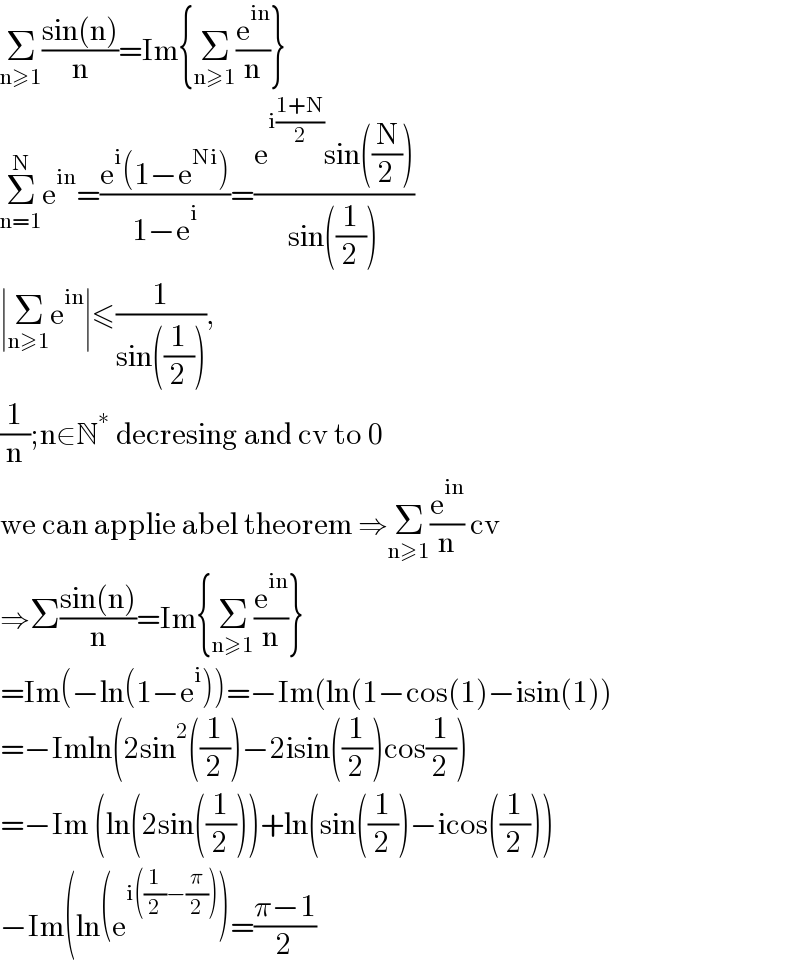
Question Number 200570 by Rupesh123 last updated on 20/Nov/23

Answered by witcher3 last updated on 20/Nov/23

$$\underset{\mathrm{n}\geqslant\mathrm{1}} {\sum}\frac{\mathrm{sin}\left(\mathrm{n}\right)}{\mathrm{n}}=\mathrm{Im}\left\{\underset{\mathrm{n}\geqslant\mathrm{1}} {\sum}\frac{\mathrm{e}^{\mathrm{in}} }{\mathrm{n}}\right\} \\ $$$$\underset{\mathrm{n}=\mathrm{1}} {\overset{\mathrm{N}} {\sum}}\mathrm{e}^{\mathrm{in}} =\frac{\mathrm{e}^{\mathrm{i}} \left(\mathrm{1}−\mathrm{e}^{\mathrm{Ni}} \right)}{\mathrm{1}−\mathrm{e}^{\mathrm{i}} }=\frac{\mathrm{e}^{\mathrm{i}\frac{\mathrm{1}+\mathrm{N}}{\mathrm{2}}} \mathrm{sin}\left(\frac{\mathrm{N}}{\mathrm{2}}\right)}{\mathrm{sin}\left(\frac{\mathrm{1}}{\mathrm{2}}\right)} \\ $$$$\mid\underset{\mathrm{n}\geqslant\mathrm{1}} {\sum}\mathrm{e}^{\mathrm{in}} \mid\leqslant\frac{\mathrm{1}}{\mathrm{sin}\left(\frac{\mathrm{1}}{\mathrm{2}}\right)},\: \\ $$$$\frac{\mathrm{1}}{\mathrm{n}};\mathrm{n}\in\mathbb{N}^{\ast} \:\mathrm{decresing}\:\mathrm{and}\:\mathrm{cv}\:\mathrm{to}\:\mathrm{0} \\ $$$$\mathrm{we}\:\mathrm{can}\:\mathrm{applie}\:\mathrm{abel}\:\mathrm{theorem}\:\Rightarrow\underset{\mathrm{n}\geqslant\mathrm{1}} {\sum}\frac{\mathrm{e}^{\mathrm{in}} }{\mathrm{n}}\:\mathrm{cv} \\ $$$$\Rightarrow\Sigma\frac{\mathrm{sin}\left(\mathrm{n}\right)}{\mathrm{n}}=\mathrm{Im}\left\{\underset{\mathrm{n}\geqslant\mathrm{1}} {\sum}\frac{\mathrm{e}^{\mathrm{in}} }{\mathrm{n}}\right\} \\ $$$$=\mathrm{Im}\left(−\mathrm{ln}\left(\mathrm{1}−\mathrm{e}^{\mathrm{i}} \right)\right)=−\mathrm{Im}\left(\mathrm{ln}\left(\mathrm{1}−\mathrm{cos}\left(\mathrm{1}\right)−\mathrm{isin}\left(\mathrm{1}\right)\right)\right. \\ $$$$=−\mathrm{Imln}\left(\mathrm{2sin}^{\mathrm{2}} \left(\frac{\mathrm{1}}{\mathrm{2}}\right)−\mathrm{2isin}\left(\frac{\mathrm{1}}{\mathrm{2}}\right)\mathrm{cos}\frac{\mathrm{1}}{\mathrm{2}}\right) \\ $$$$=−\mathrm{Im}\:\left(\mathrm{ln}\left(\mathrm{2sin}\left(\frac{\mathrm{1}}{\mathrm{2}}\right)\right)+\mathrm{ln}\left(\mathrm{sin}\left(\frac{\mathrm{1}}{\mathrm{2}}\right)−\mathrm{icos}\left(\frac{\mathrm{1}}{\mathrm{2}}\right)\right)\right. \\ $$$$−\mathrm{Im}\left(\mathrm{ln}\left(\mathrm{e}^{\mathrm{i}\left(\frac{\mathrm{1}}{\mathrm{2}}−\frac{\pi}{\mathrm{2}}\right)} \right)=\frac{\pi−\mathrm{1}}{\mathrm{2}}\right. \\ $$
Commented by Rupesh123 last updated on 20/Nov/23
Nice one!
